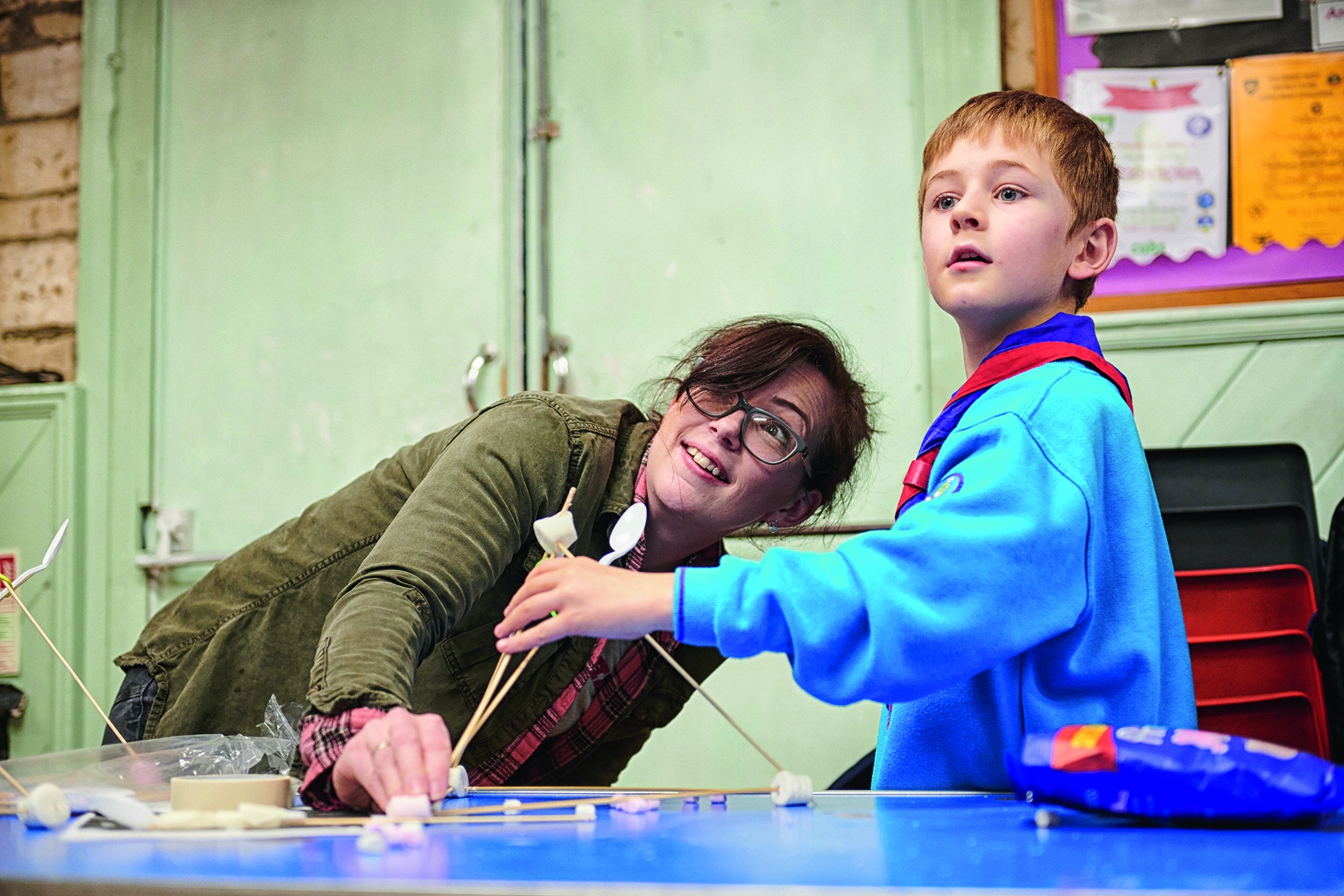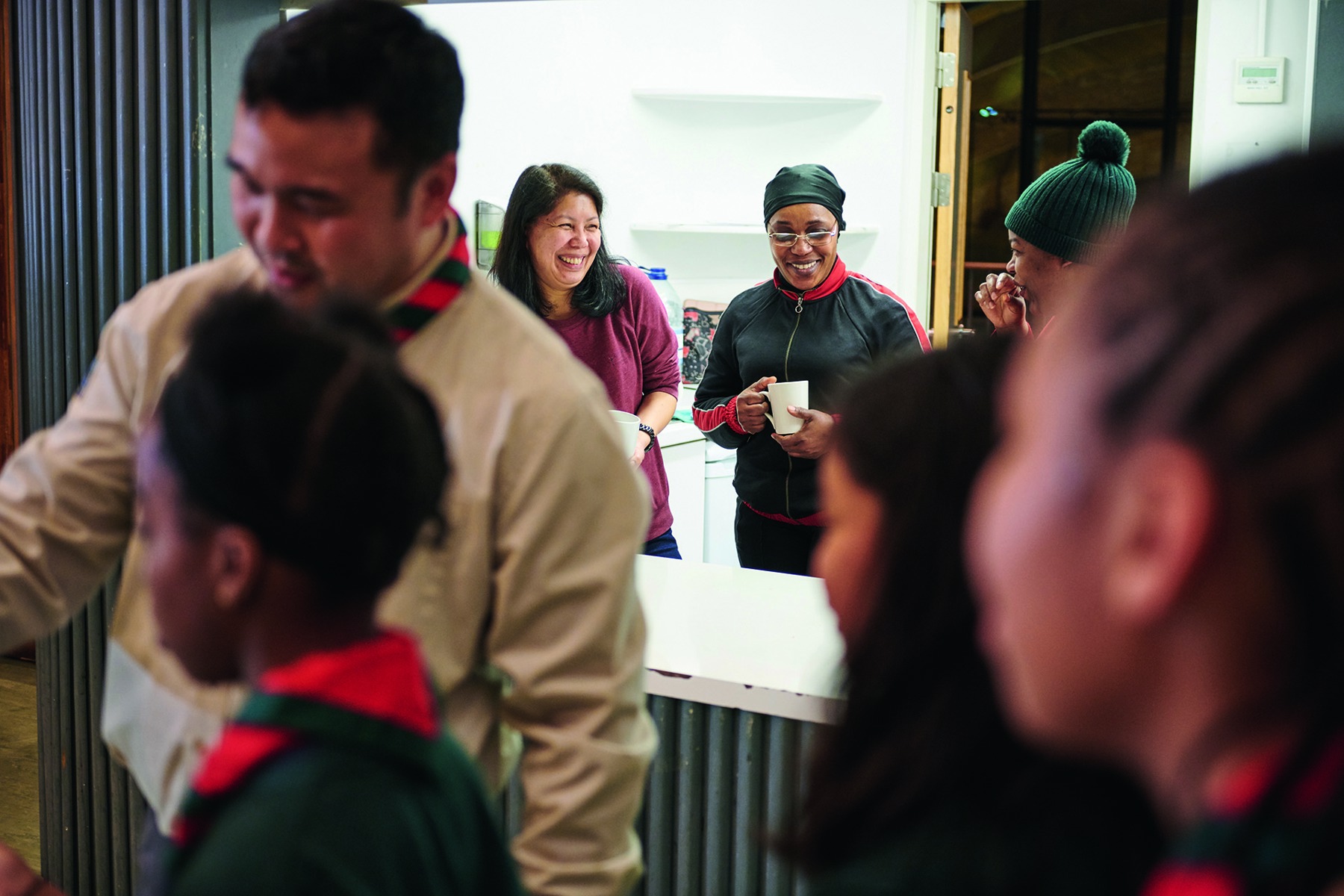Growing the family
Every Scout would love to bring more volunteers on board, but it’s not always easy to find the right people to support you and your young people. Read on to hear from volunteers who’ve tried and tested various methods to help bring people in, and to find out more about the resources we’ve put in place to help you, every step of the way.

Getting the basics right
Sometimes we’re so focussed on the big picture, we forget about the basics. Let’s start at the beginning…
Make it as easy as possible for people to find you
Is the building well lit and signposted? Is it easy to find the entrance? Are your contact details clearly displayed, so passers-by know how to get in touch? We’ve put together a checklist to help you get the little things right.
Spruce up your space (without breaking the bank)
If you share your venue with others, you might have limited control over how things are managed and decorated, but creating a welcoming atmosphere needn’t require a big budget or lots of renovation work.
Take a look around. How does your space make you feel? Is it generally clean and tidy? Does it feel homely and welcoming?
If the space feels a bit tired, simple tweaks - like putting a ‘welcome’ mat down on the doorstop or bringing in your own soap dispenser and towels if you know you’re prone to running out - can work wonders.
Talk to your neighbours
Do your neighbours know who you are? If not, pop round to say hi or post some leaflets through their letterboxes the next time you walk past.
It’s worth speaking to local businesses and service providers, too. Think about the obvious spots where activities tend to be advertised (like leisure centres, libraries and doctor’s surgeries), then branch further out. You might find extra support from unexpected sources.
Need an imagination boost? Our ‘name generation’ game is designed to get you thinking about the people you know and the skills they have, so you can be sure you’ve exhausted your community’s full potential.
Keep your details up to date (and get on Google Maps!)
Google Maps allows people to get instant directions from their location to yours, which is good news for you and even better news for Doris down the road – who’s probably fed up with being asked for directions by now.
District Commissioner for Willesden David Kitchen has put together a video tutorial to help volunteers do this.
Remember: it’s equally important to make sure your details are up-to-date on the group finder, so anyone who searches our website can find you.
Getting family members involved
Family members are an amazing – often-untapped – resource, with a whole range of ideas, insights and skills to share.
In fact, research shows 45% of new section leaders are family members of existing or prospective youth members. So, before you cast that recruitment net far and wide, it makes sense to ask for a hand closer to home…
Try the four-week challenge
The four-week challenge is a zero-commitment test-drive of Scouts, without the pushy cars salesman.
In week one, family members come along to see what we do and how we do it. In weeks two and three, they take part on their own terms – leading an activity if they feel ready, sharing a skill, or helping out with a specific task, like setting the room up or helping in the kitchen. In week four, they reflect on how things went.
Sometimes, they’ll enjoy the experience so much they sign up to become full time volunteers on the spot (yay!). Or, they might decide to help out on a more occasional basis (also yay!).
Many groups on the ground have been reporting great success with this method. Take 4th Willesden, for instance, who were able to open a Beaver, Cub and Scout sections by recruiting four parents through this method alone.
Even if those who take part don’t want to volunteer once the challenge is over, you’ll build new relationships, learn about people’s skills and motivations, and walk away with the knowledge and experience to make a more targeted ask in the future if there’s no match.
If you’d like to give it a go, we’ve put together a guide to running the challenge, with specific actions to take each week.
Make family rotas part of your everyday
Many hands make light work, so why not break down what your group needs into little tasks, and set up a rota to share the load between you?
There are a number of tools you could use to do this. Perhaps you’d prefer to stick to a traditional weekly rota, which you could stick up on the wall for people to sign up to at your meeting place? Or, maybe using a digital tool – like Whatsapp – would be more efficient.
Remember: although some family members won’t have time to spare on the ground, they might be able to do remote tasks – like setting up and managing the rota itself, or helping with admin.
Try to keep an open mind about the sorts of jobs that could be done, working to people’s strengths and preferences, and you could see a huge difference.
1st Trowbridge Beavers, for example, have been using family rotas for years to get the extra volunteers they need on a weekly basis. Today, over a dozen people who began helping on the rota have since become regular volunteers, including several section leaders, and lots of parents help out by sharing specialist skills less frequently.
Sound good? For extra support, we’ve set up a guide on how to put together a rota – including video footage of 1st Trowbridge in action.
Invite family members to your next camp
We can talk about how great Scouts is until we’re blue in the face, but a weekend of fun, adventure and skill-sharing will showcase this more than words ever could. That’s where camps and residential experiences come in.
We’ve put together a guide, with tips on what do before, during and after the event, as well as guidance around safeguarding procedures and DBS check process.
Get everyone together
Getting a bunch of adults in a room and talking to them about the fun we have at Scouts can be surprisingly effective, so why not get them involved in a Beaver Bistro, Cub Café or Scout Supper? These are evenings jam-packed with activities, where family members come along to enjoy quality time with their kids while getting a taste of what we do.
For 4th Ashby, this method has been completely transformative. After a few months of trialling it, they’ve gained four new leaders, six new occasional helpers and several new executive committee members.
We’ve put together a bunch of helpful resources on this method – including a PowerPoint presentation showcasing what Scouts is about.

Mastering the art of the welcome
Making people feel welcome when they arrive is really important if we want to retain volunteers…
Focus on the individual, their motivations and their needs
Think about the person you’re welcoming in. Are they already fairly familiar with the group, or visiting for the first time? Do they have a personal connection to Scouts (perhaps they took part themselves as a child, or are getting back into volunteering after a long break)? Or are they completely new to the concept of what we do?
Whenever you’re welcoming someone new, it’s best to ask how they’d prefer to do things rather than making assumptions or guessing. Everyone’s different, so remember to meet people where they are, and make sure they have opportunities to ask questions.
Put your hospitality hat on
Don’t forget to smile. Save space for newbies to hang up any stray coats or bags. Show them where the loo is before they need to ask. And direct them to the tea and coffee stash so they can pour themselves a cuppa.
Just make sure that in giving people access to areas that are likely separate from the main hub of activity – like communal kitchens and toilets – you’re never compromising on keeping everyone safe. As always, abide by ratios, look for potential hazards, and make sure multiple volunteers are responsible for having ‘sight and sound’ of anyone who hasn’t been DBS checked yet.
Consider buddying people up
When you’re chasing after a bunch of seven year olds, you mightn’t have time to check in on the new adult as much as you’d like to. That’s where buddy systems can help.
Speak to your existing volunteers about if they’d be willing to keep an extra eye on the newbie in the group while they build confidence.
Be mindful of using jargon
Using formal language and titles can be intimidating to newcomers. When discussing what you need help with, focus on the task you need doing rather than the role you need to fill. And, if using ‘Scout language’, like acronyms – make sure you explain what these mean.
Check in (and say thank you) often
It’s important to check in with people regularly to see how they’re finding the experience of volunteering. It’s also vital to thank people for their time.
You don’t need grand gestures to make an impact. Derek of 10th Willesden found that giving parents a certificate when they completed their four-week challenge worked wonders for group morale: spurring on parents who were new to Scouts and mightn’t have committed otherwise. But even a text or a verbal thank you can be massively effective. It’s all about showing people you value and appreciate them giving up some of their most precious resource: their time.
Share your successes with us! If you’ve found something that really works on the ground, please let us know. We’d love to learn from it and share it with others.